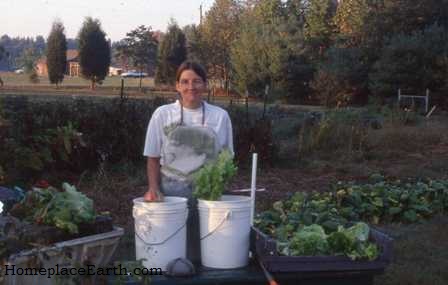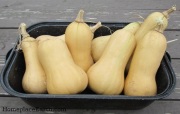 Gardeners who plant from seed, generally have some seed left at the end of the season. Knowing what kind of seed, how much, and where it is stored will help you plan your seed order for the new year. Having an inventory of your seeds could save you money by not buying more than you need, and lessen frustration when it comes time to plant, since you will know what you have and how much. If you store your seeds in more than one place, indicate where your seeds are.
Gardeners who plant from seed, generally have some seed left at the end of the season. Knowing what kind of seed, how much, and where it is stored will help you plan your seed order for the new year. Having an inventory of your seeds could save you money by not buying more than you need, and lessen frustration when it comes time to plant, since you will know what you have and how much. If you store your seeds in more than one place, indicate where your seeds are.
For many years, I used a piece of notebook paper for my seed inventory. I listed all the seeds I had on hand and made columns for how much, the source of the seeds, and the year they were bought, or the year saved if I grew them out myself. Remember, that was before computers were routinely used in the home and things weren’t so easily copied. Eventually, I developed a seed inventory form. You can see the heading for that here and you will find the form on the CD that comes with my garden plan DVD. It is also in my book Grow a Sustainable Diet. There is a link in the book that allows you to download PDFs of all the forms shown. Now I print off as many copies of the seed inventory form as I need. This year it was 11 pages! When you save seeds it is easy to accumulate a lot of seeds from different years.

A coffee filter was used for this germination test with cowpeas.
I try to inventory my seeds before the end of the growing year. This year I managed to get that completed in early December, but if times are busy, it is January before it happens. If you haven’t inventoried the seeds you have, do it now before you order new ones. As you go through your seeds, purge the ones that you know you will never plant or that you know have poor germination. Now would be a good time to do a germination test on the questionable varieties in your stash. If the ones you intend to get rid of pass the germination test, consider taking them to a seed swap, donating them to a seed library, or passing them on to your friends or new gardeners. If they don’t pass the germination test, throw them in the compost or your chicken pen, providing they are not treated, of course.
As you can see, my seed inventory has columns for Crop, Variety, Amount, Source, (empty), Don’t Buy, Do Buy, Source, Amount, and $. If you take your time with this form, you could use it to develop your seed order as you go. The Don’t Buy column is probably not necessary and you could use that space for something else. The column I left empty is sometimes used to record the days to maturity of the variety. It facilitates garden planning if that information is at your fingertips. That column could also be used to record the germination rate, if a germination test is done that year. If you know you are short on something, check the Do Buy column. Later you can go back, armed with your seed catalogs, and put in the amount of seeds you will need to buy, where you will get them and how much they will cost. Imagine, all your seed records in one place!

I list the vegetables, then the flowers and herbs, then the grains and cover crops. Each section has the crops in alphabetical order, making it easier to find things later. Each variety of a crop that I have seeds for is shown and sometimes I leave spaces for additional varieties that I intend to order. When my seed order comes in, I add those varieties to the crop inventory, and put the new seeds with my stored seeds so everything is in one place. If you don’t get around to actually recording your new acquisitions on the inventory form, put the seed order form in your garden notebook with your seed inventory.
The Garden Notebook! I assume you have put together a binder with tabs for your garden map, plant and harvest record sheets, seed inventory, and other important information. My DVD Develop a Sustainable Vegetable Garden Plan takes you through what is necessary to keep your garden records organized. You can refresh your memory be reading my blog post Keeping Garden Records.
I refer to my seed inventory throughout the year. It is easy to forget what you have. A seed inventory helps to ensure that the seeds you have purchased or saved will get planted. The seed catalogs have arrived and can be alluring, causing you to order more than you need. Before you order seeds, make your garden plan for the year so you will know just how much you need of each crop according to the space in your garden. Actually, I begin planning my garden in the fall for the coming year so that I know which cover crops go where, in preparation for the main crop in the spring and summer. Start wherever you are and go from there.
Wishing you well on your 2017 gardening year.
 Once you have gotten quite good at producing food for your table, it is natural to think of providing for others. You could casually share with your neighbors and the local food bank, but many want to take it further and exchange their extra veggies for cash. If that is where your thoughts have been leading you, I would like to offer some things for you to carefully consider before becoming a market gardener. There is a big difference between doing what you love when you have the time and turning doing what you love into a business. During my time as a market grower I grew and sold a lot of lettuce. This photo shows me washing it for a restaurant delivery.
Once you have gotten quite good at producing food for your table, it is natural to think of providing for others. You could casually share with your neighbors and the local food bank, but many want to take it further and exchange their extra veggies for cash. If that is where your thoughts have been leading you, I would like to offer some things for you to carefully consider before becoming a market gardener. There is a big difference between doing what you love when you have the time and turning doing what you love into a business. During my time as a market grower I grew and sold a lot of lettuce. This photo shows me washing it for a restaurant delivery.
 eady do, maybe it is time to expand what you are growing for your own table, rather than grow for others. How much of your staple crops, such as potatoes, sweet potatoes, onions, garlic, and grains do you grow? Are you growing enough cover crops to feed back the soil and provide all your own compost?
eady do, maybe it is time to expand what you are growing for your own table, rather than grow for others. How much of your staple crops, such as potatoes, sweet potatoes, onions, garlic, and grains do you grow? Are you growing enough cover crops to feed back the soil and provide all your own compost? Here it is– a new year and time to plan your new garden. Before you do that, however, I urge you to think about last year’s garden. Most likely, if you are reading this you probably did some sort of planning last year. That’s what my DVD
Here it is– a new year and time to plan your new garden. Before you do that, however, I urge you to think about last year’s garden. Most likely, if you are reading this you probably did some sort of planning last year. That’s what my DVD  For many years my garden plan consisted mainly of my garden maps, the one I made showing what I intended to plant where and when, the Actual version that showed what actually happened, and the Amendments version that showed what amendments were added to each bed and when. It is the Actual version that will help you plan this year’s garden. If you completed it you will know what was in each bed throughout the year and when it was planted, particularly, what is in there now; but the subject of
For many years my garden plan consisted mainly of my garden maps, the one I made showing what I intended to plant where and when, the Actual version that showed what actually happened, and the Amendments version that showed what amendments were added to each bed and when. It is the Actual version that will help you plan this year’s garden. If you completed it you will know what was in each bed throughout the year and when it was planted, particularly, what is in there now; but the subject of 














